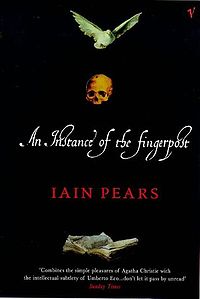This novel is set in Oxford during the restoration in the 1660s, a time of complex intellectual, scientific, religious and political ferment and uses a mix of both real and fictitious historical figures. The murder of Dr Robert Grove, a fellow of New College, and the events surrounding it are narrated from four significantly different points of view. Marco da Cola, a Venetian Catholic doctor newly arrived in Britain; Jack Prescott, son of a Royalist traitor and desperate to clear his father’s name; John Wallis, one of the mathematical giants and a cryptographer to the courts of both Cromwell and Charles II; and Anthony Wood, an antiquary.
At the heart of the story is the prime suspect, Sarah Blundy, daughter of a religious dissenter and from the class which hoped the end of the civil war would establish equality for all people, “making the earth a common treasury for all.” Those with the power to destroy and raise up governments could not tolerate such hopes because of the belief in the superiority of the ruling classes and the fear that “if anyone can achieve power, then all will try, and government becomes a mere battle in which principle is sacrificed for interest. The lowest will impose themselves, for the best will shun the gutter.”
The worldviews of the main characters are mediated by different forms of Christianity. However despite strongly held religious differences, the Catholic Venetian and the Protestant English gentlemen share a belief in the divide between “lowest” and “highest.” Sarah, one of those “lowest,” serves as the fingerpost to a nonconformist and more radical religious and political perspective.
